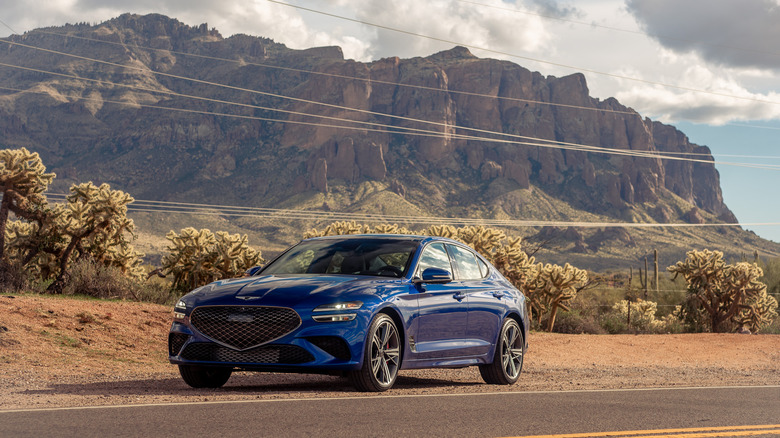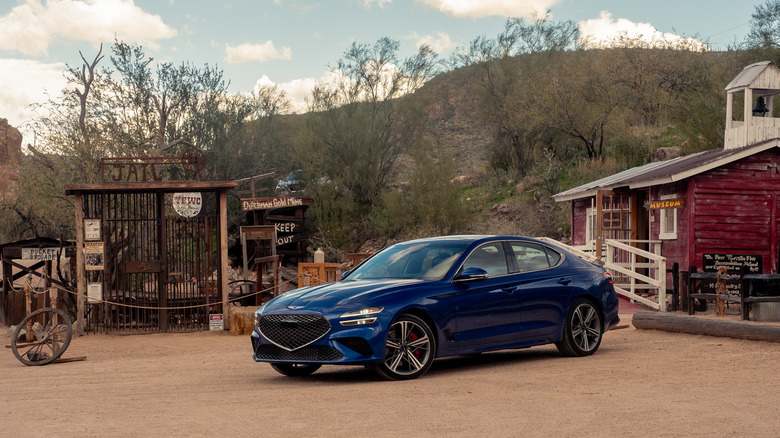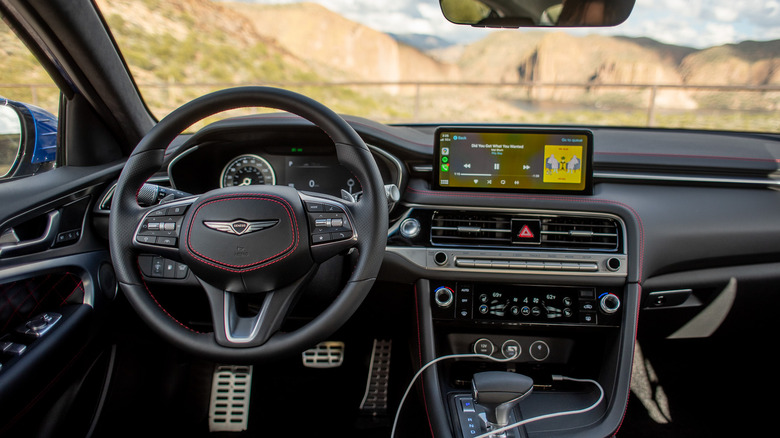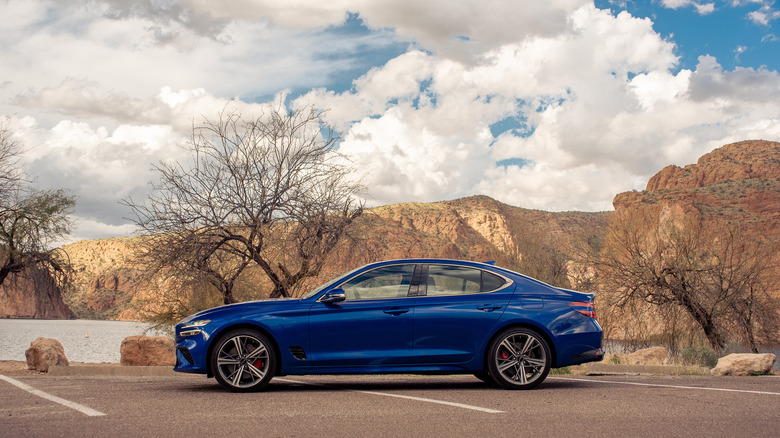2024 Genesis G70 First Drive: Real Luxury, Great Value, Confusing Values
I'm starting my third lap at Apex Motor Club, a race-track playground built a few years ago for the well-heeled to stretch the legs of their 911 GT3s and Vette ZR1s outside the confines of speed limits and radar guns. In front of me, keeping pace, is an actual professional driver, and I am desperately fighting my car just to keep him in view. We head into a high-speed left-hander just past Pit Lane. I slam on the Brembos just past the braking point cones, stabbing the pedal after turn-in to try and coax the rear end around in a ham-fisted attempt at aiming the heavy nose toward the apex. The car steadfastly refuses to rotate. I continue understeering. I try a new approach. I stomp the throttle as soon as I smack the curbing, feel the rear end start sliding, and keep my foot in it.
The "Traction Control Off" icon prominently displayed on the dash is lying, and software quickly halts my slide. The car cuts the throttle. I lose boost. The lead car pulls away. I curse the car.
I'm not surprised: I'm in a Genesis G70. The newest refresh that brought me out here is powerful, no doubt — 365 horsepower in the twin-turbo V6 model I'm currently hooning — but this is really not a car meant for hotlaps. I had the rest of the day in Phoenix, Arizona to figure out what, exactly, it is the car for.
The Pricemaster
Before I'd begun hanging the rear end loose at Apex, I knew the G70 was definitely for the bargain-hunting luxury shopper. At $42,795 after destination, the G70 is one of the cheapest midsizes in the luxury sedan market, and with its upgraded base engine — a 2.5-liter four-cylinder cranking out 300 horsepower — it's also the most powerful standard-equipped model.
Buyers get a long list of standard active and passive safety features, Genesis's stop-and-go Highway Driving Assist system, heated front seats, Brembo brakes, 19-inch wheels, and a 12-way adjustable electric driver's seat as standard equipment. Upgrading from standard rear-wheel-drive to all-wheel-drive is only $2,100 upcharge, on any model with either drivetrain. The more powerful 365 HP 3.3L twin-turbo starts right around $50,000, undercutting most similarly-powerful competitors by thousands. From a value-for-money perspective, the G70 is virtually impossible to beat at any trim level.
Stylistically? Chillin'
The car gets new styling for 2024, with the single-piece headlights swapped out for a pair of LED "wings" bracketing a chrome-laden grille. The rear gets a matching set of dual tails, with a pair of chrome-tipped oval exhaust outlets. Inside, buyers will sadly find fewer buttons than last year's model, as the physical climate controls have been substituted with a dedicated screen like in the larger G90 sedan. A small amount of haptic feedback and its always-on nature makes it one of the more usable climate touchscreens on the market, luckily.
Lower trims with leatherette feel nicely-equipped, with pleasant material choices, and high-trim 3.3-liter twin-turbo models get quilted Nappa leather door-panel inserts that feel decidedly premium. Despite the standard Brembos and powerful engines, the G70's redesign tends heavily toward elegant, rather than brutish.
Demeanor? Meaner
Of course, the way I began my day with the G70 was at 110 miles an hour down the back straight at Apex, which revealed the car's performance strengths. Those Brembos are indeed worth having, with a gentle initial bite that is easy to modulate all the way to ABS-inducing force. The suspension — electronically-dampened on the top-model 3.3T Sport Prestige I was driving — coordinates nicely with the optional Pilot Sport 4 tires and pleasantly stiff chassis to deliver sure-footed cornering performance. The 3.3-liter twin-turbo V6 is righteously quick out of a corner, and the Sport Prestige offers a mechanical LSD, which helps significantly with putting that power to the pavement.
It's what surrounds this chassis and drivetrain that demonstrates that Genesis wasn't really aiming for the track-day crowd. The eight-speed transmission refuses to hold gears, even in Sport+ mode. Shifts are fairly quick but even under ridiculously hard braking, the transmission steadfastly refused to feed me downshifts with nearly the aggression I'd want on a spirited drive, much less a track day. The steering rack on the 3.3T has a variable-ratio — larger in the center, smaller on the ends — which makes it difficult to make mid-corner adjustments consistently, as I could never know how much steering angle any given correction would actually result in. That rack is also fairly silent as far as communicating understeer, with only tire noise and a general lack of desire to turn-in as the hints that I was on the verge of plowing with the front. This is unfortunate, as the weight of the V6 makes the G70 really understeer.
Sport+ mode is also probably going to be a disappointment for rear-wheel-drive buyers; the traction control is "off" but angle is extremely heavily policed, to the point that aiming the car with the throttle is a non-starter at anything above 35 MPH. (This is more aggressive than some competitors are with the traction control on.) Drift mode is available on all-wheel-drive models, but as my track car was the purist-preference rear-wheel-drive model, I couldn't actually find out how aggressive that setting was.
Lone Ranger
A brief autocross session in the 2.5T revealed that model — with a normal-ratio steering rack and much less weight up front — turned in more directly and required a lot less effort to change directions in. Unfortunately, putting down power in that car has its own challenges, as the rear-wheel-drive model has no mechanical LSD option, so I one-wheel-peeled quite a bit at autocross. (For the people reading this article 20 years from now, wondering if a beat-up used G70 will make a good drift car — sorry to be the bearer of bad news, but keep looking.)
But it's almost as hard to imagine a modern G70 buyer at autocross as it is to envision them on the track, so I needed a more realistic challenge. I hopped into a fully-loaded 3.3T Sport Prestige all-wheel-drive model ($57,745 after destination) for a drive through the coiling back roads of Tonto National Forest outside of Phoenix. With the winding, smooth pavement of our National Forest system as my test loop, the G70 felt a bit more at home.
The G70 confirmed to me here that it's definitely tuned as a sports sedan. Ride quality is stiff, not cosseting, and body roll and fore-and-aft pitching during hard braking and turning is totally absent. Although the cabin is largely well-insulated from droning, the engine note comes through loud and clear under hard acceleration, and acceleration is hard with the all-wheel-drive package — 0-60 arrives somewhere in the five-second range. While the G70 has no dedicated sport label like its competitors do, it's clear the 3.3T is squarely aimed at the Type S's and M Sports of the world.
Searching for the natural habitat
Despite this, the variable-ratio steering rack and relatively numb wheel meant the twisties weren't all that fun. It's unfortunate, as the chassis and drivetrain tuning would make the G70 a raucously fun canyon-carver if it just had a different rack; as it sits, it's got about the same steering communication as most modern BMW sedans, so buyers cross-shopping both likely will be satisfied with either, but it could be much more engaging overall.
The cabin in more-laid back conditions was pleasant, although not as gentle as more road trip-minded tourers are. Still, it's undoubtedly luxurious: material choices on the Sport Prestige are excellent, and the seats are comfortable. The physical switchgear in the center of the dash feels well-built, and even with the new touchscreen's arrival there are still actual knobs for temperature and stereo controls.
The infotainment software is quick-responding, and the touchscreen — an ultra-wide 10.25-inch unit — is easy to reach and stayed well out of my eyeline while I was wheeling through Tonto National Forest. Wired Apple CarPlay and Android Auto are standard, as well, and popping on Spotify revealed that the optional Lexicon 15-speaker sound system was bass-favoring, but overall clear enough.
My largest gripe with the G70's cabin is that I found the ergonomics awkward for my leg-biased 6'1" frame. The spec sheet says the G70 is about as roomy as its competitors — 38.7 inches of head room with a sunroof, 42.6 inches of legroom — but to position myself comfortably, my ear was essentially at the B-pillar, which — in combination with the relatively high side window beltline — made me feel like the interior was cramped.
The smart choice?
The clear strength the G70 has is the same one it did when Genesis introduced it six years ago: absurd value. It now has the most powerful base engine and the lowest price in the luxury midsize class. Those base models are still sufficiently well-equipped to make entry-level buyers feel pampered. Fully-loaded models still feel like an incredible deal per dollar. The 2024 G70 is a very rational buy for logical buyers.
But for those who make emotional purchases, the G70's case is less clear-cut. It blends genteel style with high-impact handling, leading to a car that's neither truly sporty or laid-back. It seems confused about what it wants to accomplish, and it means that it can't tug at the heartstrings the same way some of its more expensive or less-equipped competitors can. Many people will like the Genesis G70, but I suspect fewer will fall in love with it.






